How to Plan a Kitchen? 16 Expert Design Tips
6 November 2023
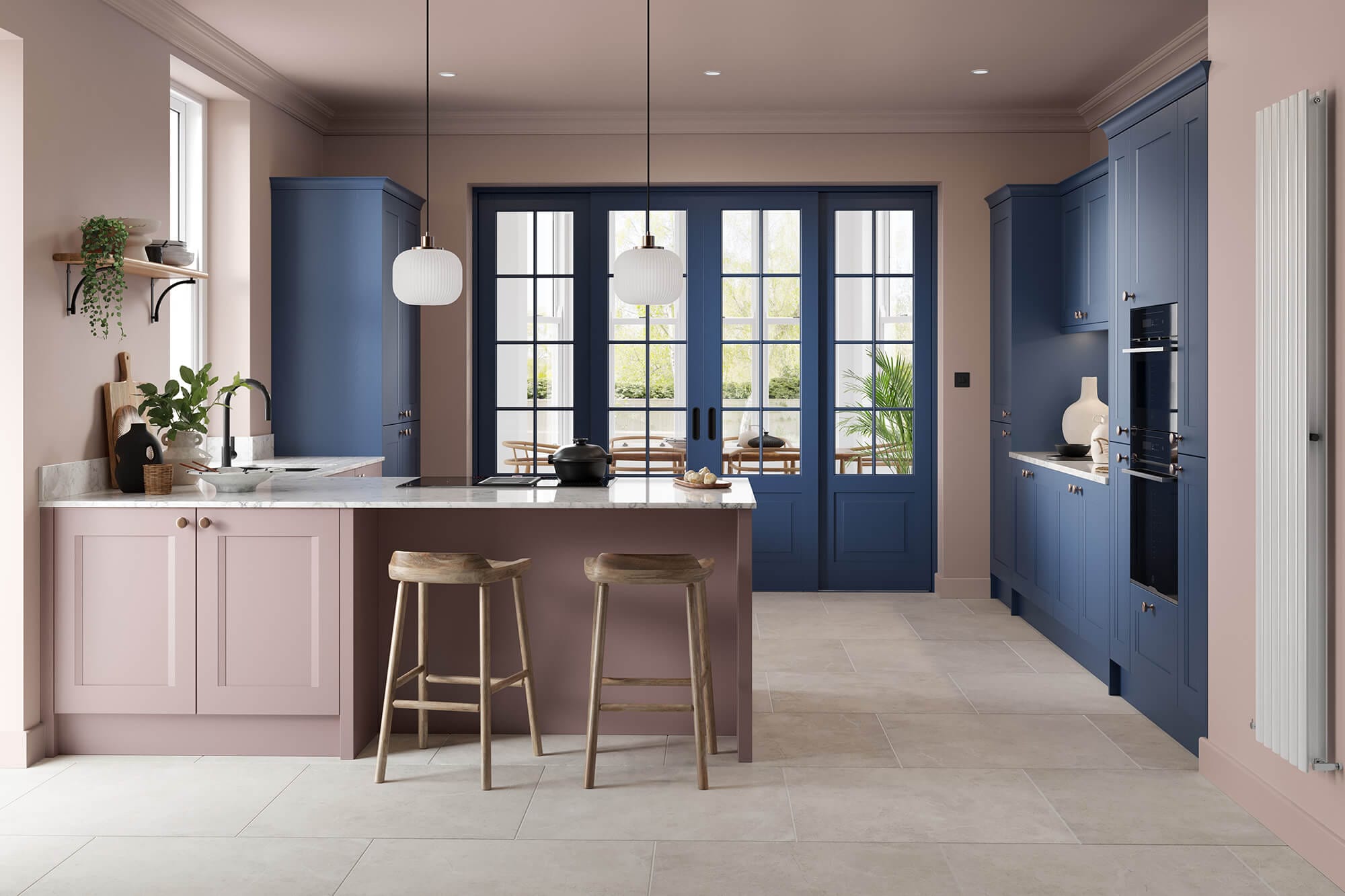
Your kitchen is more than just a place where meals are prepared; it’s the heart of your home, a space where family and friends gather, stories are shared, and memories are created. Designing a kitchen that not only meets your culinary needs but also reflects your lifestyle and personal taste can be both exciting and daunting.
This guide is here to help you learn 16 of the top tips which will help make the process easier. From understanding your space to choosing the perfect kitchen layout, from establishing your budget to selecting the right materials and appliances, we have covered every aspect you need to consider.

16 Helpful Tips for Designing a Kitchen
- Understanding Your Space
- Establishing Your Budget
- Defining Your Style
- Choosing the Kitchen Layout
- Work Triangle and Kitchen Zones
- Selecting Cabinets and Storage Solutions
- Countertop Materials and Installation
- Splashback Ideas
- Choosing Appliances
- Choosing the Sink and Tap
- Flooring Options
- Lighting Plan
- Seating and Dining
- Choosing Colours
- Ventilation
- Planning for the Unexpected
1. Understanding Your Space
Your kitchen is the heart of your home, and like any organ, understanding its dimensions is vital. First, kitchen measurements are your blueprint – they include wall-to-wall, floor-to-ceiling, and distances between key features like appliances, windows, and doors. It’s critical to measure with precision to avoid unnecessary hiccups later in the kitchen remodel process.
Now, kitchen space planning starts. It’s like putting together a complex jigsaw puzzle where each piece represents an appliance or piece of furniture. Consider practicality, functionality, and aesthetics when deciding on the placement of these elements. Remember, the kitchen isn’t just for cooking; it’s a hub for family and social gatherings.
Kitchen layout considerations are closely related to space planning. Standard layouts include U-shaped, L-shaped, and galley kitchens. These layouts offer optimal space usage and a balance between the three main kitchen zones: food preparation, cooking, and cleaning.
Don’t forget to factor in kitchen windows and doors. They affect the placement of appliances and cabinets and play a significant role in natural lighting and ventilation. Ensure they’re not obstructed by kitchen units and offer a clear path for movement.
The kitchen plumbing layout is another pivotal part of your kitchen design. The placement of sinks and dishwashers is usually dictated by existing plumbing. Consult with a professional if significant changes are required.
Similar to plumbing, the kitchen’s electrical layout must be accounted for. This includes the locations of outlets, switches, and appliances. Keep in mind, it’s always easier and less expensive to plan your layout around existing electrical points unless a major renovation is in place.

2. Establishing Your Budget
Knowing your budget early on is key to a successful kitchen redesign. To establish your kitchen renovation budget, take into account your home’s overall value. Generally, investing 10-20% of your home’s worth is a good starting point.
The cost of kitchen remodelling can vary widely, but some aspects disproportionately affect the budget. Major factors include cabinetry, appliances, countertops, and labour costs. These are areas where you need to decide if you’ll splurge or save.
For effective budgeting for a kitchen renovation, first determine your “must-haves”. Next, assign a tentative budget for each category, ensuring a balance between aesthetics and function. Remember to include a contingency for unexpected costs.
Kitchen remodelling costs can be managed effectively by being mindful of your choices. For instance, opting for mid-range appliances instead of high-end ones can save a significant amount. Choosing laminate over stone for countertops is another cost-effective option.
So, planning a kitchen budget is not just about how much you spend, but where you spend it. By prioritising your needs and wants, you can achieve a cost-effective kitchen remodel that suits your taste and lifestyle without breaking the bank.

3. Defining Your Style
Your kitchen style should be a manifestation of your individuality and preferences. The design identity you select will steer the decisions you make regarding kitchen units, appliances, worktops, and decorative elements.
Modern-style kitchens are noted for their clean lines, minimalist approach, and creative storage solutions, often integrating state-of-the-art appliances and materials like stainless steel and quartz.
Shaker-style kitchens feature a simple, unadorned design with an emphasis on quality craftsmanship and functionality. They usually incorporate wooden cabinets with recessed panel doors, and a muted, neutral colour palette.
Country-style kitchens are warm and inviting, with a homely charm. They often incorporate wooden furniture, open shelves, traditional textiles and soft, muted colours.
Industrial-style kitchens are favoured for their raw, utilitarian aesthetics, exposed pipes, and rugged materials like concrete and metal, contributing to an edgy, urban feel.
Farmhouse-style kitchens radiate a comfortable, homey feeling with their vintage hardware, open shelving, and use of warm, natural materials like wood and stone.
Scandi-style kitchens exemplify simplicity, functionality, and minimalism, featuring a blend of textures and muted tones with the occasional bright colour accent.
Rustic-style kitchens evoke a cosy, country feel, using raw, natural materials like wood and stone, combined with earthy colours to create a warm, welcoming environment.
French-style kitchens are known for their balance of elegance and rustic charm, utilising soft colours, ornate woodwork and vintage furniture.
Lastly, American-style kitchens are known for their spacious design, with a large island at the centre, abundant storage, and cutting-edge appliances.
Defining a kitchen style is a personal task rather than a one-size-fits-all solution. Feel free to borrow aspects from various styles to create a kitchen design that is uniquely tailored to you.

4. Choosing the Kitchen Layout
Selecting the appropriate kitchen layout is a fundamental step in designing your dream kitchen. Each kitchen layout has its unique benefits and is better suited to specific lifestyles and space constraints.
The galley kitchen, with its efficient corridor-style design, is perfect for smaller spaces. This layout features two parallel runs of cabinets and appliances, ensuring everything is within easy reach.
An L-Shape kitchen works well in medium to large spaces. It offers a flexible layout with ample countertop space and storage. It also provides an open design that integrates well with dining or living areas.
For larger kitchens, the U-Shape kitchen is a popular choice. It provides plenty of storage and counter space, with cabinets and appliances lining three walls.
The Island kitchen adds a freestanding workspace in the centre of the room. This design not only provides extra prep space but also serves as a social hub.
A Peninsula kitchen is similar to the island kitchen but connects the freestanding workspace to the rest of the kitchen, providing a great solution for homes with limited space.

5. Work Triangle and Kitchen Zones
The kitchen work triangle concept refers to the optimal spatial relationship between the fridge, stove, and sink. A well-designed work triangle ensures efficient movement and workflow in your kitchen.
Your kitchen is composed of multiple kitchen zones, each with a specific purpose:
Prep zone: This is where you chop, dice, and mix ingredients. It should ideally be located near the fridge and a small appliance garage.
Cooking zone: This includes the stove and oven. Store pots, pans, and cooking utensils nearby.
Cleaning zone: This includes the sink and dishwasher. It should be in close proximity to the trash and recycling bins.
Storage zone: This area is for storing dishes, cutlery, and other kitchen essentials.
Designing your kitchen with these zones in mind can streamline your cooking process and increase overall efficiency.

6. Selecting Cabinets and Storage Solutions
Kitchen cabinets are a significant investment, so choose wisely. They contribute greatly to the overall aesthetic and functionality of your kitchen. Cabinet styles range from modern to traditional, with variations in door profiles, internal storage and colours.
The cabinet finish you choose can dramatically change the look of your kitchen. Options include painted, grained, glazed, smooth and vinyl-coated finishes.
When it comes to kitchen storage solutions, think outside the box. Innovative options such as pull-out racks, pan drawers, internal drawers, larder units and corner cabinet carousels can maximise storage and accessibility.
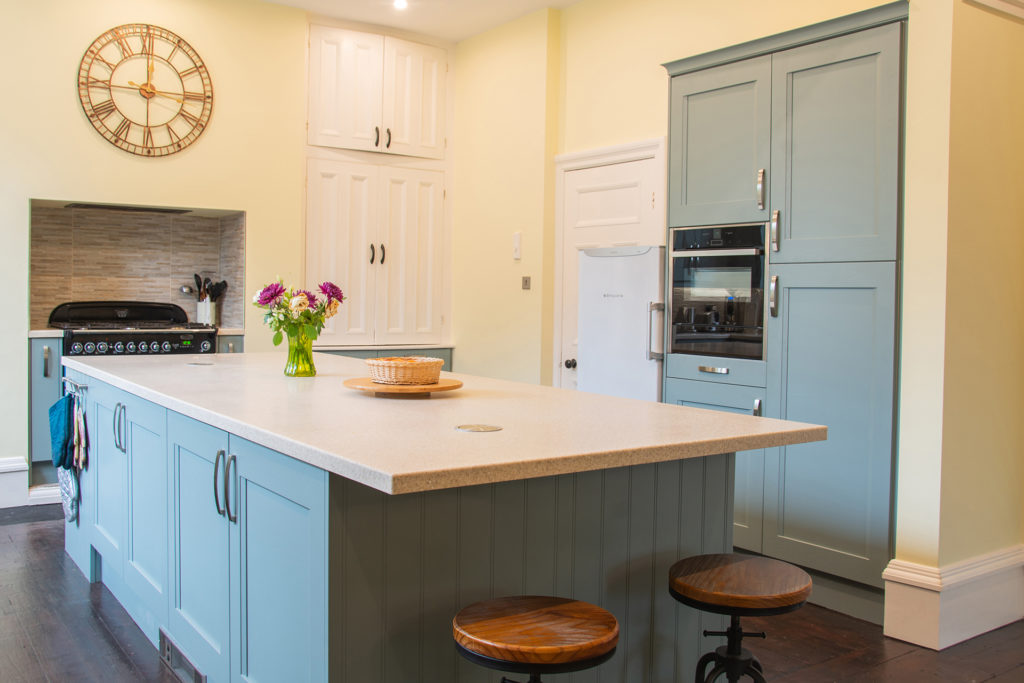
7. Countertop Materials and Installation
Your countertop material is another essential element of your kitchen design. It needs to be durable, easy to clean, and in line with your style.
Granite countertops are a popular choice for their luxurious appearance and high durability. However, they require regular sealing to prevent staining.
Quartz countertops are engineered products offering a wide variety of colours and patterns. They’re extremely durable, non-porous, and require less maintenance than granite.
Laminate countertops are cost-effective and available in an array of colours and patterns. They are, however, less resistant to scratches and heat.
Wood countertops add a warm, natural element to your kitchen. They require regular sealing to prevent damage from water and stains.
Regardless of the material you choose, professional countertop installation is crucial to ensure longevity and proper fit.
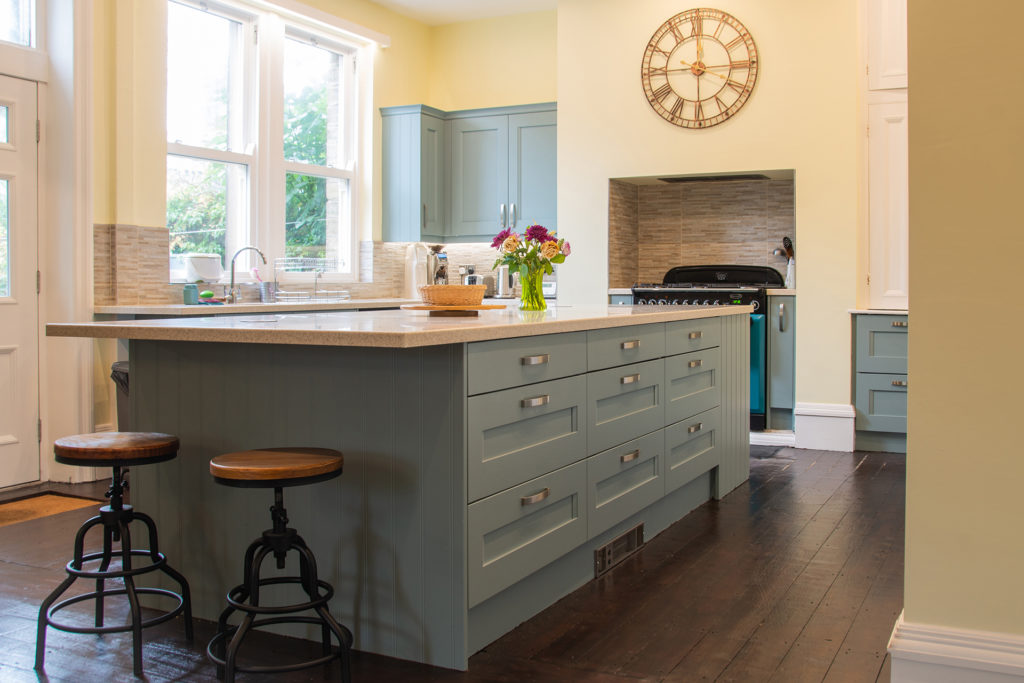
8. Splashback Ideas
The kitchen splashback not only serves a practical purpose but also offers an opportunity to inject style and personality into your kitchen. Kitchen backsplash ideas can range from minimalist to ornate, depending on your preference.
There are numerous splashback materials to choose from. Ceramic or porcelain tiles offer a classic look and are available in a myriad of colours, shapes, and sizes. Splashbacks to match the worktops in granite, quartz or laminate keep a clean continuous look. In most cases, people go for a simple upstand and go full height behind the hob or sink.
Creative splashbacks extend beyond just tiles. Consider options like stainless steel for a contemporary or industrial look. Be adventurous with your tile backsplash design; try different shapes, like hexagonal or herringbone patterns, for a unique effect. Whilst glass splashbacks can have bespoke colours or images creating a truly individual look.
Whatever you choose, make sure it offers adequate kitchen wall protection against splatters and stains, while adding to the overall appeal of your kitchen.
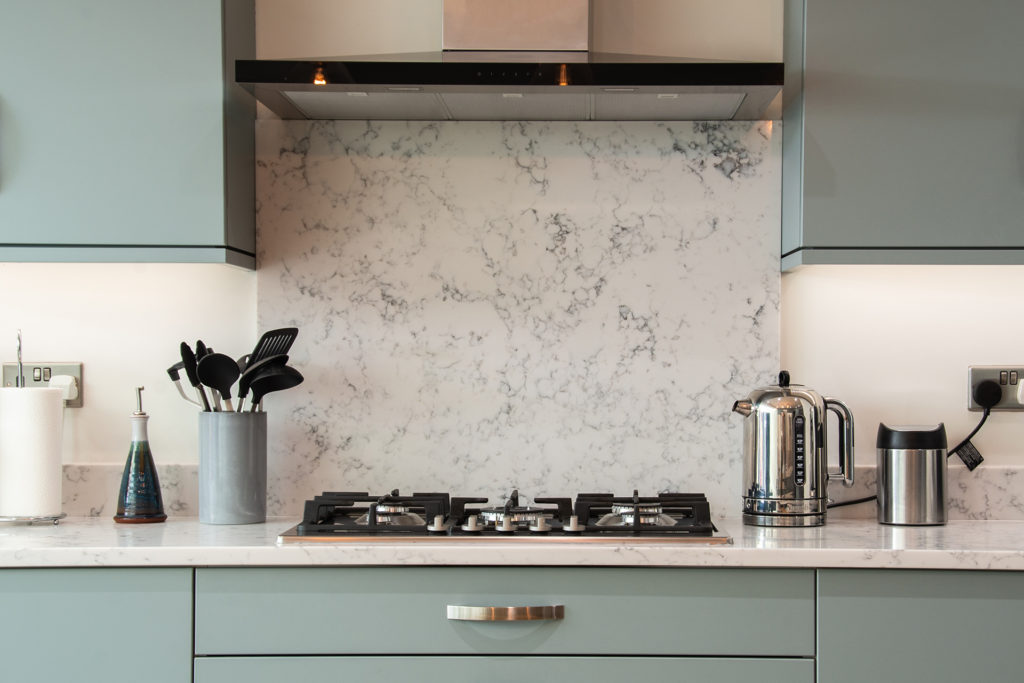
9. Choosing Appliances
When it comes to kitchen appliances, their selection must be driven by functionality, aesthetics, energy efficiency, and space considerations.
Opt for energy-efficient appliances to save on your utility bills and reduce your carbon footprint. Appliances like refrigerators, dishwashers, and ovens come with energy ratings; the higher the rating, the better the efficiency.
Integrated appliances are built into your kitchen cabinetry for a seamless look. They offer a streamlined appearance and are ideal for minimalist or small kitchens.
Smart kitchen appliances, such as programmable cookers and fridges that alert you when you’re running low on groceries, offer enhanced convenience and functionality.
Appliance sizes should be in harmony with your kitchen size. An oversized appliance might overpower a small kitchen, while undersized ones may look out of place in a large kitchen.
It’s always worth investing in trusted brands that have a good warranty and will stand the test of time.
It’s also worth considering the location of your appliances i.e. traditionally ovens were put at a low level, but now it’s more common to have integrated ovens at a higher level to access them easily and have a combination of stacked appliances, like microwaves and combination ovens.
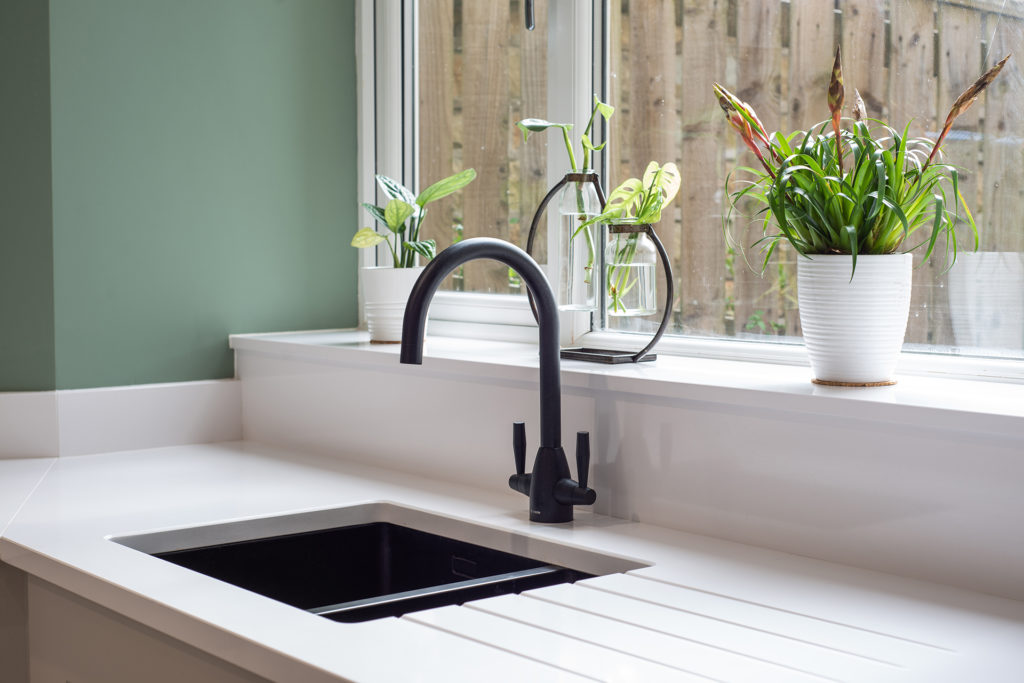
10. Choosing the Kitchen Sink and Tap
Your kitchen sink is likely the most utilised element of your kitchen. Hence, selecting the right sink and tap should perfectly balance practicality and aesthetic appeal.
Sink materials vary from stainless steel and cast iron to composite and fireclay. Each material presents its own merits and disadvantages with regard to resilience, maintenance, and cost.
Kitchen taps come in an array of styles and finishes, including pull-out, pull-down, commercial-style, and motion-detecting. Opt for a design that harmonises with your sink and the overall kitchen decor.
The correct sink installation method can significantly enhance your kitchen’s overall appearance. Choices encompass under mount, top mount, flush mount, and farmhouse installations.
Guarantee that your sink and tap coincide in style, size, and finish to generate a cohesive aesthetic.

11. Flooring Options
Kitchen flooring options are varied and should be chosen based on your lifestyle, budget, and kitchen style.
For durable kitchen floors, consider hardwood, which offers a timeless appeal, or porcelain tile, which resists scratches, stains, and moisture.
Easy maintenance floors include vinyl and linoleum. They resist stains and moisture, and spills can be cleaned up with a simple wipe.
When choosing a floor, it’s crucial to consider flooring style matching. Your kitchen floor should complement other elements in your kitchen, creating a cohesive and harmonious look.
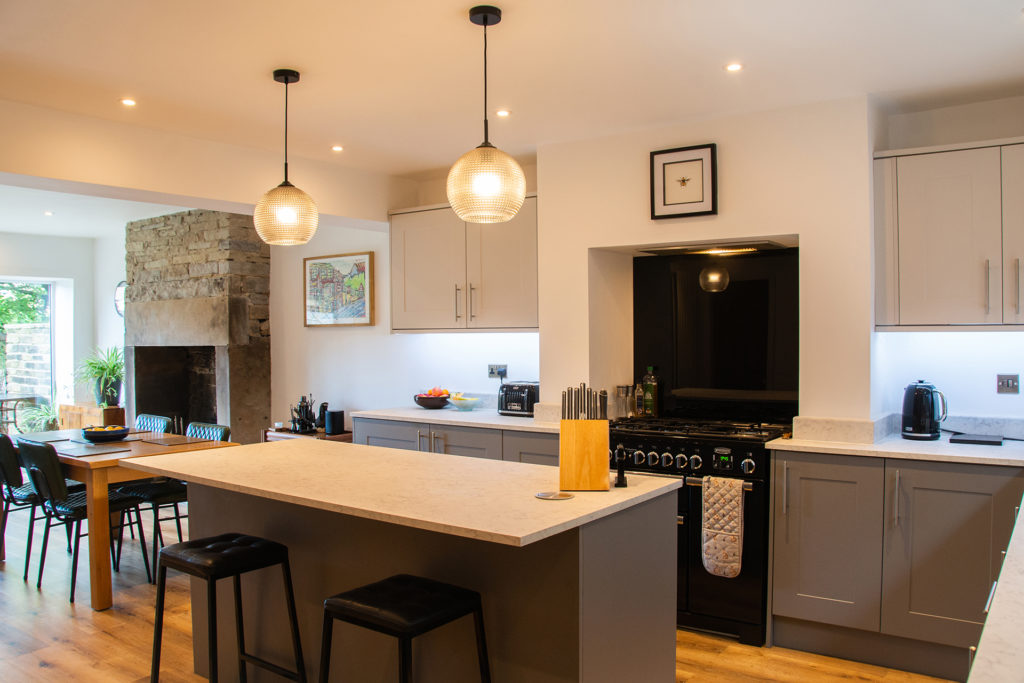
12. Lighting Plan
An effective kitchen lighting plan not only enhances the aesthetics but also improves functionality.
Task lighting provides illumination for work-intensive areas like countertops, sinks, and stoves. This could be in the form of under-cabinet lighting or pendant lights.
Ambient lighting creates a warm and welcoming environment, perfect for casual dining or socialising. This can be achieved through ceiling-mounted or recessed fixtures that give off a diffused light.
Accent lighting adds depth and dimension to your kitchen. It can highlight architectural features or display items. Use it inside glass-front cabinets or above open shelving.
Your choice of kitchen light fixtures should blend in with the overall design style of your kitchen while catering to these different lighting needs.

13. Seating and Dining
Kitchen seating options have evolved significantly. The kitchen is no longer just a place for cooking, but also for socialising, dining, or even working.
A kitchen dining area could range from a simple breakfast nook to a full-fledged dining table, depending on your space and lifestyle.
Incorporating seating in the kitchen can be as simple as adding stools to a kitchen island or peninsula. This kitchen island seating or kitchen breakfast bar setup encourages interaction and makes the kitchen more versatile.
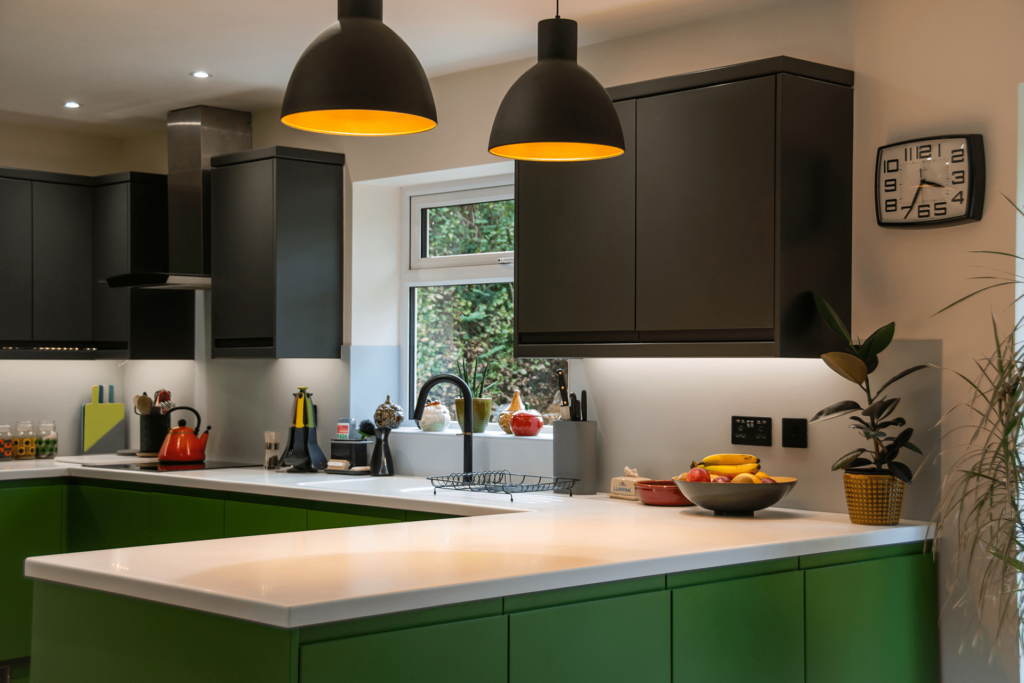
14. Choosing Colours
The kitchen colour scheme plays a pivotal role in setting the mood and character of your kitchen.
Choosing kitchen colours involves considering all the elements – cabinets, countertops, backsplash, appliances, and flooring. They should all work together to create a harmonious look.
Consider kitchen paint colours that complement your cabinets and countertops. Also, keep in mind that lighter colours can make a small kitchen look larger, while darker hues can add a touch of drama and depth.
When selecting kitchen cabinet colours, consider the effect you want to create. Do you want them to stand out as a focal point, or would you prefer them to blend in with the rest of your design?
The right colour palette for your kitchen will depend on your personal preference, the kitchen’s style, and the overall palette of your home.

15. Ventilation
Proper kitchen ventilation is crucial for indoor air quality and to extend the life of your appliances.
Kitchen range hoods are the most common form of ventilation. They help eliminate smoke, heat, and cooking odours, improving the kitchen environment.
The importance of kitchen ventilation extends beyond just air quality. It can also help reduce grease build-up on your cabinets and walls, making cleaning easier and preserving your kitchen’s appearance.
There are different types of kitchen hoods, including wall-mount hoods, under-cabinet hoods, ceiling-mounted hoods, and downdraft ventilation hoods. The choice will depend on your kitchen layout and cooking needs.
Kitchen extractor fans are another effective ventilation option, especially for smaller kitchens. These fans can be installed in the ceiling or wall and work to expel air outside, helping to keep your kitchen fresh and clean.
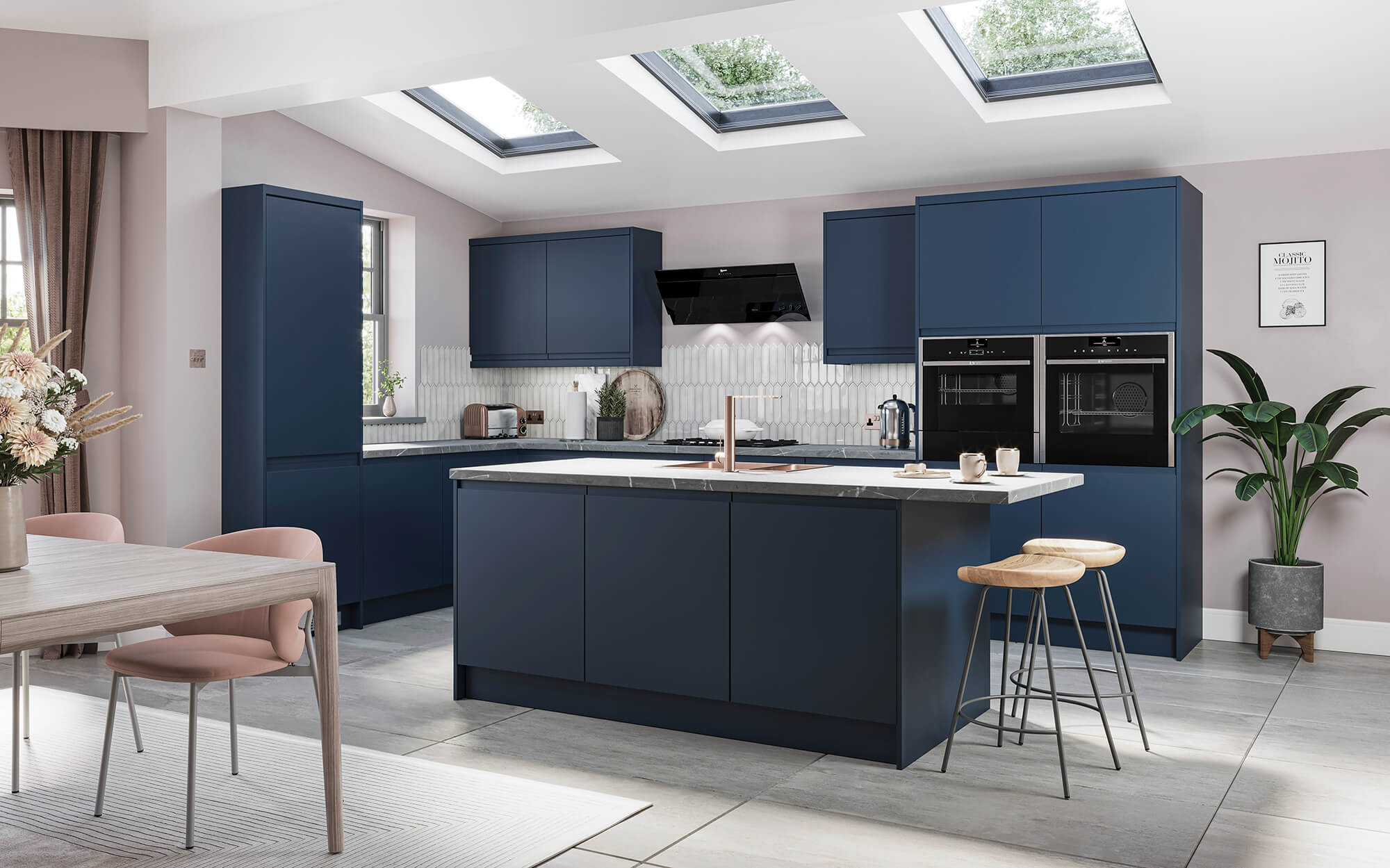
16. Planning for the Unexpected
When it comes to kitchen remodel planning, it’s crucial to anticipate potential hiccups.
Planning for renovation delays is wise. This could be due to unforeseen structural issues, shipping delays, or even changes in your own decisions.
Always consider budgeting for extra kitchen remodel costs. It’s a good rule of thumb to set aside an additional 10-20% of your budget for unexpected expenses.
Managing kitchen remodelling challenges requires flexibility and patience. It’s crucial to maintain clear communication with your contractor and designer to quickly address any issues.
Preparing for unforeseen renovation issues not only prevents stress but also ensures that the project stays on track, despite the challenges.
Planning and designing your kitchen may seem overwhelming, but with the right approach and thorough consideration of all aspects, it can also be an enjoyable journey. Take your time, consider your options, and remember that your ultimate goal is to create a functional, comfortable, and appealing space that serves your needs and reflects your lifestyle and preferences. We hope that the expert tips shared in this guide inspire and empower you to design a kitchen that you will love for many years to come. Happy kitchen planning!
Looking for expert advice? Ready to start a project? Get in touch!
We offer full-service residential renovations – from initial meeting to completion. Our experts have years of experience in the building and construction industry. Book a consultation with us today.